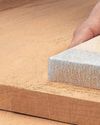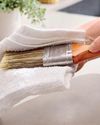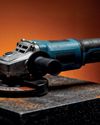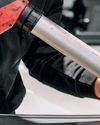HOW TO USE ANCHORS TO FASTEN OBJECTS TO A WALL
The Home Handyman
|March/April 2023
Anything you hang from a wall - whether it's a simple family picture or large wall shelf unit will require that the item is attached directly and firmly, with the weight safely distributed. The fastener you use will vary according to the weight of the object and the type of wall construction.
-

Our guide looks at what masonry anchors are, what they are used for, and the different types available.
What is masonry?
Before we explain what masonry anchors are, we must first define masonry itself. In its simplest form, masonry can be described as anything that a mason puts down. In other words, if it is laid by a stonemason or a bricklayer, then it is masonry. This can include building materials such as stone and brick, as well as block walls.
Blockwork walls are made from blocks that are commonly known as breeze block, Thermalite block, concrete blocks, or cinder block. Blocks are typically much quicker to lay than brick, so they are often used for the interior walls of modern houses. The walls are then covered with plaster or plasterboard to provide a smooth finish.
What are masonry anchors?
So, considering that, anchors for masonry are simply fixings used to fasten or attach an item to masonry. Strong and durable, they are designed for reliability and to provide a secure hold.
Traditionally, screws are used to fix items to masonry, but this method has its limitations with certain materials. It is not possible to screw directly into brick, stone, or block walls hence the need for specialist masonry anchors.
Plastic wall plugs and masonry anchors can help to achieve a secure fitting when fixing items to walls. They work by expanding against the hole you have drilled in the masonry, as the screw is screwed into the wall. This creates a highly secure and tight-fitting hold on the screw - providing that the wall is made from solid masonry or concrete.
What are masonry anchors used for?
Masonry fixings are anchors used to fasten or attach an item to masonry. They can be used with various kinds of masonry including brick and blocks, as well as concrete.
Using masonry plugs on different building materials is explored in further detail below:
Denne historien er fra March/April 2023-utgaven av The Home Handyman.
Abonner på Magzter GOLD for å få tilgang til tusenvis av kuraterte premiumhistorier og over 9000 magasiner og aviser.
Allerede abonnent? Logg på
FLERE HISTORIER FRA The Home Handyman

The Home Handyman
KEEP YOUR HOUSE CRITTER FREE
With winter fast approaching, outdoor critters seeking to regulate their temperature are trying their best to get inside. Ants, spiders, moths, mosquitoes, fruit flies, stink bugs, termites, silverfish, and ladybugs, to name a few, can easily make their way into homes, and once they've settled in, it's often hard to get them out.
6 mins
Jul/Aug'25

The Home Handyman
SECRET HIDEOUTS
We all have things we would prefer to keep out of plain sight - family heirlooms, wedding rings, expensive jewellery, medicines or even weapons. Sometimes we just want to keep household items hidden in order to declutter a space. Whether you want to hide items for safety or financial reasons, or simply want to keep your bedroom tidy, there are a few clever storage ideas that could help you out.
2 mins
Jul/Aug'25

The Home Handyman
ABRASIVES DEMYSTIFIED
Abrasive materials are indispensable in countless industries, from woodworking and metal fabrication to automotive repair and electronics manufacturing.
3 mins
Jul/Aug'25

The Home Handyman
THINNERS VS. TURPENTINE
If you've ever finished a painting or staining job and been left wondering how best to clean your brushes, you're not alone. One of the most common DIY questions is: Should I use thinners or turpentine to clean my brushes? The answer depends on the type of paint or coating you've used. Using the wrong solvent can damage your brushes, or worse, make the cleaning job even harder.
2 mins
Jul/Aug'25

The Home Handyman
KEEP THE COLD OUT
Did you know that homes in South Africa are either insulated to a poor standard, compared to European nations, or have no form of insulation at all. In 2011 our National Building Regulations made it compulsory to fit thermal insulation in new buildings and additions to building structures.
5 mins
Jul/Aug'25

The Home Handyman
ANGLE GRINDERS — MASTERING THIS VERSATILE TOOL
When it comes to versatile tools in a DIYer's arsenal, few can match the power and practicality of the angle grinder.
2 mins
Jul/Aug'25

The Home Handyman
KITCHEN CARE – MAINTENANCE TIPS FOR KEY AREAS
The kitchen is the heart of the home where meals are made, memories are shared, and chaos sometimes reigns. But like any hardworking space, your kitchen needs regular maintenance to keep it functional, safe, and looking great.
2 mins
Jul/Aug'25

The Home Handyman
Separating Fact from Fiction
Maintaining your home can be a daunting task, especially with the plethora of DIY tips and tricks floating around the internet.
2 mins
Jul/Aug'25

The Home Handyman
SEALANTS SIMPLIFIED: WHAT TO USE AND WHERE
Whether you’re tackling a weekend DIY fix, remodelling your home, or involved in large-scale construction, sealants are a silent hero that play a vital role in creating watertight, airtight, and secure finishes.
3 mins
Jul/Aug'25

The Home Handyman
COMMON FRIDGE/FREEZER FAULTS
Your fridge freezer is one of the hardest-working appliances in your home, so when it stops performing as it should, it can cause major inconvenience. The good news? Not every fault means an expensive call-out or a trip to the shops for a new one. In many cases, you can fix the issue yourself with a little know-how and a few basic tools.
3 mins
Jul/Aug'25
Translate
Change font size

